Ask Professor Puzzler
Do you have a question you would like to ask Professor Puzzler? Click here to ask your question!
Find a, b, and c if a + b + c = 5; a2 + b2 + c2 = 29, and a3 + b3 + c3 = 83.
This is an interesting problem, and some clever manipulation may be required.
EQ 1: a + b + c = 5
EQ 2: a2 + b2 + c2 = 29
EQ 3: a3 + b3 + c3 = 83
Let's start by observing that if we square the first equation, we get:
EQ 4: a2 + b2 + c2 + 2ab + 2bc + 2ac = 25.
Subtracting (2) from (4), and simplifying, gives:
EQ 5: ab + bc + ac = -2
Now let's (3), and rewrite it with a3 + b3 factored:
EQ 6: (a + b)(a2 - ab + b2) +c3 = 83.
Ideally, it would be nice if we could rewrite (6) in terms of c. We note the following:
(1) can be rewritten as: a + b = 5 - c
(5) can be rewritten as ab = - 2 - bc - ac = -2 - c(a + b) = -2 - c(5 - c) = c2 - 5c - 2
(2) can be rewritten as a2 + b2 = 29 - c2
Substituting these into (6) gives us:
EQ 7: (5 - c)(29 - c2 - c2 + 5c + 2) + c3 = 83
We simplify this equation as follows:
(5 - c)(-2c2 + 5c + 31) + c3 = 83
2c3 - 15c2 - 6c + 155 + c3 = 83
3c3 - 15c2 - 6c + 72 = 0
c3 - 5c2 - 2c + 24 = 0
This is a cubic equation, so we naturally expect three answers. And this makes perfect sense, in light of the problem; the equations are symmetric with respect to a, b, and c, so once we find three values for c, we know that any combinations of those three values make ordered triples (a, b, c) that work.
I don't see a quick solution by grouping, so I resort to the rational root theorem until I find a value that works; then I factor the resulting quadratic to obtain -2, 3, and 4, in any order.
Thanks for the problem; that was a fun one!
Carol from South Paris asks, "After parentheses and exponents, order of operation is Multiply or Divide before Add and Subtract, then go left to right....but I'm puzzled about this one: 60 divided by symbol 5 (7 - 5). Is the answer 24 or 6? Thank you."
Hi Carol, I know exactly what you're talking about; I've been seeing this (and variations on it) cropping up on Facebook regularly in the last few days. It's funny how these things go in streaks. First it's problems about fruits and flower petals, and then people get tired of those, and it's back to order-of-operations again! Here's what the meme looks like, to help those who haven't seen it.
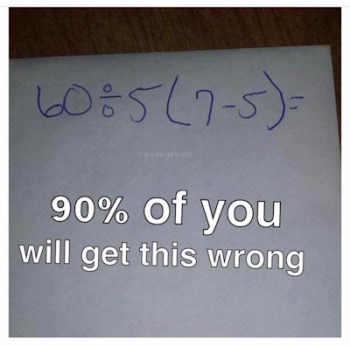
There are two common answers to this problem, and I show both ways of evaluating it below:
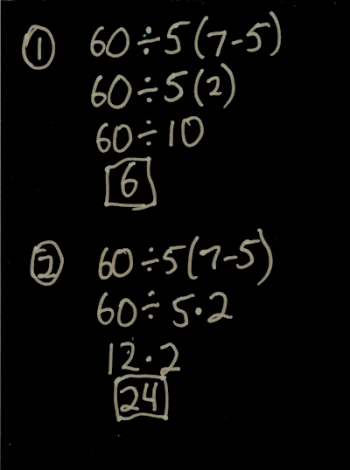
Why do people come to two different answers? And which one is correct?
There are two issues that lead to the confusion. The first is that when you first learned PEMDAS (or BODMAS, or whatever you called Order of Operations), you probably had not learned about the juxtaposition of parentheses with numbers and variables - if you saw this problem as a child, you probably saw it like this: 60 ÷ 5 x (7 - 5). That problem is entirely unambiguous. The correct order was to do the subtraction inside the parentheses first, then the division, and then the multiplication, giving you an answer of 24.
When you learned Algebra (or Pre-Algebra) you started using juxtaposition of parentheses with numbers, variables, and other parentheses to represent multiplication: 5(x + 1), x(x + 1), (x + 1)(x + 2). In each case, those can be thought of as: 5 · (x + 1), x · (x + 1), and (x + 1) · (x + 2). BUT...even though they "mean the same thing" you became trained, through usage, to treat the juxtaposed parentheses as an inviolable grouping. the 5 and the (x + 1) go together like peanut butter an jelly. This makes you, the algebra student, want to do the first evaluation method.
In PEMDAS we say that we do parentheses first. But what does that mean? Does it mean "Do what's inside the parentheses first," Or does it mean "Do what's inside and then combine the result with whatever the parentheses are juxtaposed with."? If you can't answer that question, you can't answer the meme.
What's the other issue here? The other issue is the fact that the operation symbol before the juxtaposed parentheses is a division symbol. If you stop to think about it, there wouldn't be an issue if it was multiplication, addition or subtraction. The problem would not have confused anyone if it had been 60 - 5(7 - 5) or 60 + 5(7 - 5).
This actually came up in my Algebra One class yesterday; we were discussing operation symbols, and I told them that in our algebra class, we would almost never use the division symbol used in this problem. Instead, we would use a vinculum (a horizontal fraction bar) to represent division.
Using a fraction bar removes the ambiguity from this problem, because if you use a fraction bar, you must make a choice in writing it out, as shown below.
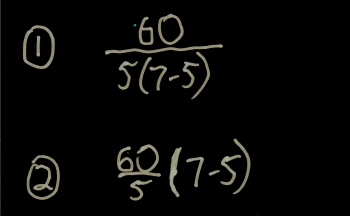
Okay, sure; we can make it unambiguous by changing our notation. But...who is right?
That question is a little tougher. You can find respected math websites and math video bloggers who come down on either side of the issue. And everyone tends to be emphatic that their interpretation is absolutely 100% correct. But that's not the worst of it; Texas Instruments made two different calculators (TI82 and TI83) that would evaluate this differently; one would give 6 as the answer, and the other would give 24.
For this reason (and I think it's a sufficient reason) I won't come down on one side or the other. Because if I told you that the first way was right, someday you'll be using the calculator that evaluates using the second method, or vice-versa. Until all our software consistently evaluates these things the same way (or refuses to evaluate them *), it's not safe to adamantly insist on one or the other. Instead, I tell my students, "If you're doing something like this on a calculator, always put in parentheses to clarify the meaning." But the reality is, this never comes up in my math classes, because we use the vinculum instead of the division symbol. You should do the same.
* People post screenshots of their desktop calculator (Windows) evaluating this to 24, but they never stop to think that they're actually changing the symbolic representation of the problem, because the Windows calculator refuses to do juxtaposition - it requires the use of a multiplication symbol. And since this problem is really all about symbolic representation, you cheated when you did that!
Professor Puzzler's brother, who is also a math teacher, and a coach of math teachers, adds the following advice that he gives his students:
- Estimate your answer first.
- Make sure you know how your calculator works on order of operations.
Seventh grader Lucie from Australia asks, "How do you do scientific notation?"
That's a great question, Lucie. There are a couple reasons why we have scientific notation. The first reason is that many numbers are either so big or so tiny that they are hard to write out without scientific notation. For example, would you like to know the distance from the Milky Way to Andromeda galaxy? The distance is:
d = 23,600,000,000,000,000,000,000 meters
Would you like to know the size of a water molecule? The size is:
w = 0.0000000025 meters
Both of those numbers are a nuisance to write. The first one because it's so big, and needs a lot of zeroes, and the second one because it's so small and needs a lot of zeroes! If only there was a way to avoid writing all those zeroes! Well, that's the good news about scientific notation; it lets us avoid all that writing.
If you're writing a big number with scientific notation, you're going to ask yourself, "How many places would I need to move the decimal to the left in order to have only one digit in front of the decimal? In the case of the Andromeda distance, if you moved the decimal 22 places to the left, you would have the decimal right between the 2 and the 3. Once you've figured that out, you can write the number as:
d = 2.36 x 1022 meters
Notice that we didn't have to write all those zeroes! We put the decimal after the first digit, and then we wrote the number of places we had to move the decimal as an exponent of 10.
We do the opposite for very small numbers: we ask, "How many places would I need to move the decimal to the right in order to have one non-zero digit in front of the decimal?" In the case of the size of a water molecule, if we wanted the decimal to to be after the two (the first non-zero digit), we would need to move it 10 places to the right. Once you've figured that out, you can write the following:
w = 2.5 x 10-10 meters
Note that we used a negative exponent this time. That's because we were moving the decimal ten places in the other direction. And again, we get to skip all those zeroes, making it easier to write.
I said there were a couple reasons for writing numbers in scientific notation. One reason, as shown above, is to make them easier to write. The other reason is to make them easier to read and understand. Let me show you an example.
Which number is bigger: 23,500,000,000,000,000,000 or 4,200,000,000,000,000,000?
In order to answer my question, you had to count the number of groups in each number to find out which one was bigger. Suppose it was written this way instead:
Which number is bigger: 2.35 x 1019 or 4.2 x 1018?
This is so much easier! If both numbers are properly written in scientific notation, the number with the larger exponent is bigger! And what if they have the same exponent? Then you compare the numbers in front of the multiplication. For example:
Which number is bigger: 3.4 x 1032 or 4.5 x 1032?
In this case, both numbers are in scientific notation, and they both have an exponent of 32. So we just compare 3.4 and 4.5. Since 4.5 is bigger, we know that 4.5 x 1032 is the larger number.
I hope that helps, Lucie!
Seventh grader Joe asks, "Can you come up with a better approximation to the Golden ratio than the fraction 8/5?"
Hi Joe! The answer to that question is: definitely!
Before we dive into approximations, do you know how to write the exact value of the golden ratio? It's (1 + √5)/2. If you punch that in your calculator (be sure to include the parentheses!) you'll get approximately 1.618.
The fraction 8/5 is 1.6, which is not bad, but we can definitely get closer!
One way to do it would be to take the golden ratio and shift the decimal one place, drop of everything after the decimal, and then put it over ten.
16/10
Of course, you can do the same thing, and get a better approximation, by shifting the decimal twice and dividing by 100:
161/100
Or 1618/1000. You get the idea, right? But that's kind of a cheater way of doing it, because it requires you to already know the value of the golden ratio!
So let's talk for a moment about how someone came up with the approximation 8/5. There's a very simple method for arriving at that fraction, and once you know the method, you can create your own approximations.
Are you familiar with the Fibonacci Sequence? It's a list of numbers. The first number in the list is 1, the second number in the list is 1, and each number after that is the sum of the two previous numbers in the list.
F1 = 1
F2 = 1
F3 = 1 + 1 = 2
F4 = 2 + 1 = 3
F5 = 3 + 2 = 5
F6 = 5 + 3 = 8
F7 = 8 + 5 = 13
F8 = 13 + 8 = 21
F9 = 21 + 13 = 34
Now if you look at those numbers, you might notice that F5 = 5 and F6 = 8. Those are the two numbers in your ratio! That might get you wondering...what if I picked two other adjacent Fibonacci numbers? Like 13 and 8? Well, 13/8 = 1.625, which is bigger than the golden ratio, but is closer to it than 1.6. So let's try the next two numbers in the sequence: 21/13 = 1.61538... This is smaller than the golden ratio, but is closer still! 34/21 = 1.619... Closer still!
You get the idea, right? If you take any two fibonacci numbers that are adjacent to each other, and divide the larger one by the smaller, you'll get an approximation of the golden ratio. The further down the list you go, the more accurate your approximation is.
For example, to pick two really big Fibonacci numbers: 317811/196418 = 1.618033988738303...
This is accurate to ten decimal places! Of course, it's not easy to remember, and it also isn't very easy to use. Whereas, 8/5 is both easy to remember and easy to use.
So 317811/196418 is better, but only in the sense that it is more accurate. It might be a good way of impressing your friends (or even your teacher), but that's about all it's good for.
Thanks for asking, Joe!
As an added note to this, below is an interesting graph which can help you visualize the approximations that you get by taking ratios of successive terms of the Fibonacci sequence.The horizontal orange line represents the golden ratio. The jagged blue line that alternately goes above and below the golden ratio is the sequence of ratios.
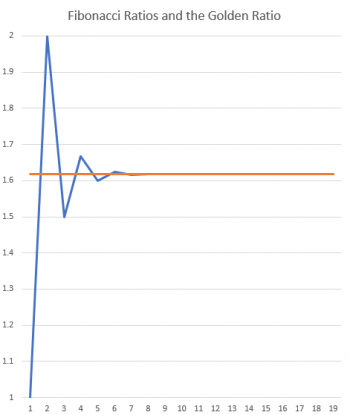
For example, the first point is 1/1 = 1, the second point is 2/1 = 2, and the third point is 3/2 = 1.5. After that, the sequence quickly converges on* the golden ratio, so that after the eighth or ninth value, you can't even see the blue line any more. That doesn't mean that those approximations equal the golden ratio; just that the difference is so small that it's less than a pixel on the screen!
No two of the ratios are the same value. They alternately flip back and forth between being too large and being too small forever, with the difference between the approximation and the actual value getting closer and closer to zero.
* "converge" is a mathematical term that means (roughly) "getting closer and closer to a certain value, without ever reaching it."
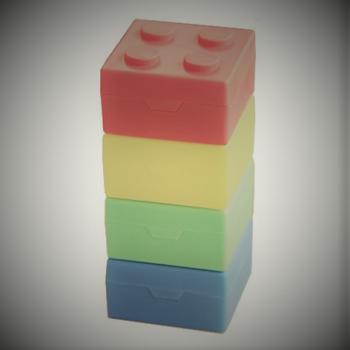
Good morning, and welcome back to school, for those of you who are students! I know that for many of you, school began back in mid-August, but I always think of the day after Labor Day as "Back-to-School" Day - that's just a holdover from my childhood days!
Now that school is back in session, we're starting to get some interesting questions again, so be sure to check back from time to time to see what's new!
A question came to us yesterday from seventh grader Jenny in the Philippines. She wants advice on solving the sort of problem where people are working together. Here's an example of this sort of problem:
Jack and Jill can build a LEGO tower in four hours. If Jack, working by himself, can do the job in five hours, how long would it take Jill to do the job by herself?
First of all, I should point out that this sort of problem always has a built-in assumption that never gets talked about. It's the assumption that the childrens' combined speed of work is equivalent to their individual speeds added together. Depending on the job and the people, this is not necessarily a reasonable assumption. For instance, Jack and Jill could end up getting in each others' way, and therefore slow down the process. Maybe they don't get along well, and fight over how to build the tower. Or maybe they get along quite well, and spend more time talking than building! Often the job in a problem like this will be something like "mowing a lawn," since on a job like that they can work independently and separately, without slowing each other down.
Okay, so we make the assumption that their combined speed is the sum of their individual speeds. In other words, if Jack can build 10 towers per hour, and Jill can build 12 towers per hour, then together they should be able to build 22 towers per hour.
Notice what the units of speed are in this problem: towers per hour. This is a fractional unit, with the number of towers on top, and the number of hours on the bottom.
So we'll say A = Jack's speed, B = Jill's speed, and C = their combined speed
A + B = C
How fast can Jack build a tower by himself? 1 tower every five hours. So A = (1 tower)/(5 hours) = 0.2 towers/hour
How fast can they build a tower together? 1 tower every four hours. So C = (1 tower)/(4 hours) = 0.25 towers/hour
Thus,
0.2 + B = 0.25
B = 0.05 towers/hour
If she builds at a rate of 0.05 t/hr, and we want to know how long it takes to build one tower, our unknown is H, the number of hours:
1 tower = (0.05 t/hr)(H hr)
Divide both sides by 0.05 to obtain: H = 1/0.05 = 20 hours. If Jill works by herself, it'll take her 20 hours to do the job. Does this make sense? Sure! If Jack works by himself it takes him five hours. If Jill helps, it takes four hours, which isn't that much different from Jack's rate, which suggests that Jill works pretty slowly!
So that's the general process, and you can apply that to a wide variety of 'working together' problems. You can even do this with more than two people working together. Thanks for asking, Jenny!

